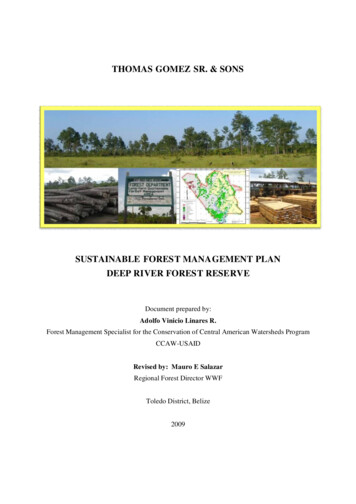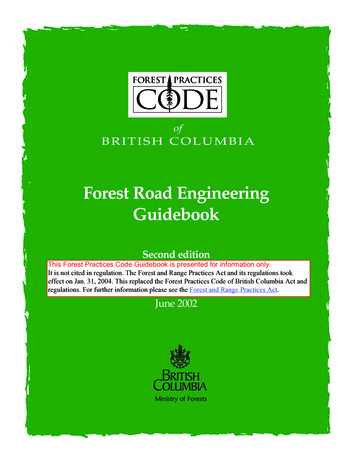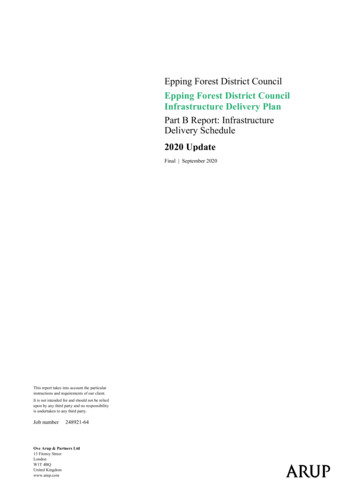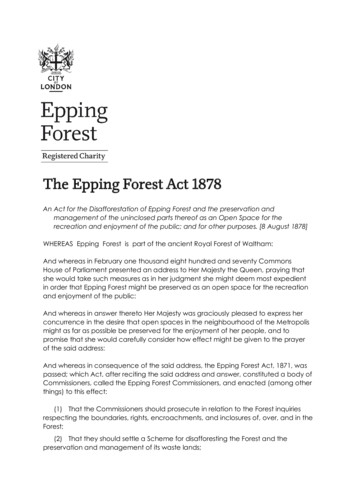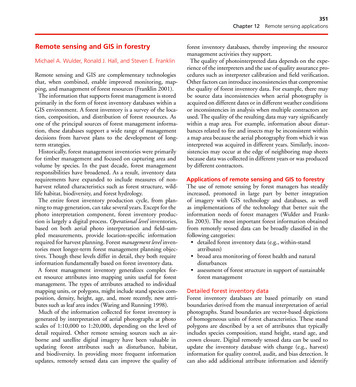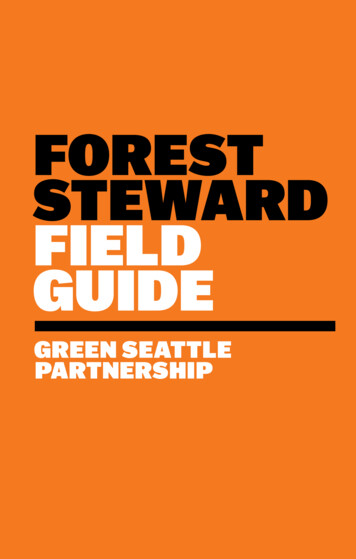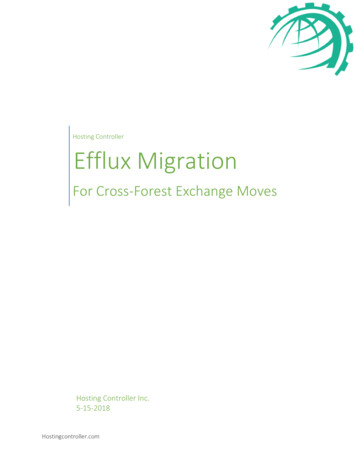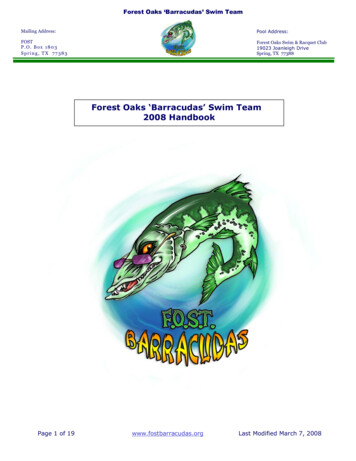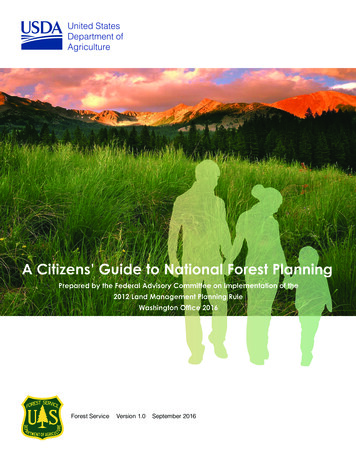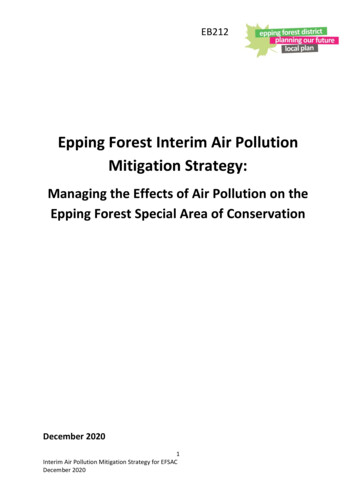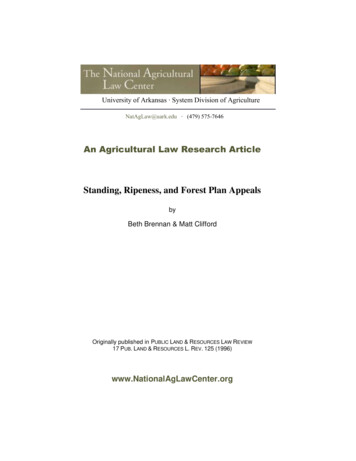
Transcription
University of Arkansas System Division of AgricultureNatAgLaw@uark.edu (479) 575-7646An Agricultural Law Research ArticleStanding, Ripeness, and Forest Plan AppealsbyBeth Brennan & Matt CliffordOriginally published in PUBLIC LAND & RESOURCES LAW REVIEW17 PUB. LAND & RESOURCES L. REV. 125 (1996)www.NationalAgLawCenter.org
STANDING, RIPENESS, AND FOREST PLAN APPEALSBeth Brennan·Matt Clifford··I. INTRODUCTIONAt the beginning of this decade, the Supreme Court issued two deci sions that at fIrst blush appeared to revolutionize the doctrine of standingand ripeness, especially for environmental-group plaintiffs. I Both Lujan v.National Wildlife Federation (NWF) and Lujan v. Defenders of Wildlife(Defenders) were authored by Justice Antonin Scalia, who has writtenextensively about his belief that standing doctrine has allowed too muchaccess to the courts.2 Scholars immediately began debating whether NWFand Defenders would signifIcantly affect environmental law, but it was notuntil 1994 that the federal circuit courts of appeal split in their interpreta tion of the decisions.The split took place in the context of challenges to Land and Re source Management Plans (forest plans) issued by the United States ForestService under the National Forest Management Act (NFMA).3 In 1993,the Ninth Circuit held that plaintiffs have standing to challenge forestplans. 4 In 1994, the Eighth Circuit Court of Appeals denied standing tosimilar plaintiffs.s In 1995, the Seventh Circuit followed the Ninth andheld that plaintiffs have standing to challenge forest plans. 6In Sierra Club v. Robertson, the Eighth Circuit noted and criticized J.D. 1995, University of Montana School of Law. Ms. Brennan is in private practice inMissoula. Montana.The authors would like to thank Jack Tuholske, Joan Card, and Steve Place for their invaluableassistance. J.D. 1995, University of Montana School of Law.1. Lujan v. National Wildlife Fed'n, 497 U.S. 871 (1990); Lujan v. Defenders of Wildlife, 504U.S. 555 (1992).2. See Antonin Scalia, Vennont Yankee: The APA, the D.C. Circuit, and the Supreme COUTt,1978 SUP. Cr. REv. 345 [hereinafter Scalia, Vennont Yankee]; Antonin Scalia, The Doctrine ofStanding as an Essential Element of the Separation of Powers, 17 SUFFOLK L. REv. 881 (1983) [here inafter Scalia, Separation of Powers]. See also Morrison v. Olson, 487 U.S. 654 (1988) (Scalia, J.,dissenting).3. 16 U.S.C. §§ 1600-1614 (1994) (amending the Forest and Rangeland Renewable ResourcesPlanning Act).4. Resources Ltd., Inc. v. Robertson, 8 F.3d 1394 (9th Cir. 1993) (relying on Idaho Conser vation League v. Mumma, 956 F.2d 1508 (9th Cir. 1992) (holding that plaintiffs have standing tochallenge the EIS accompanying a forest plan».5. Sierra Club v. Robertson, 28 F.3d 753 (8th Cir. 1994).6. Sierra Club v. Marita, 46 F.3d 606 (7th Cir. 1995).
126PUBLIC LAND & RESOURCES LAW REVIEW[Vol. 17the Ninth Circuit's holdings on standing.? The Eighth Circuit's opinion,however, incorrectly analyzes the holdings of both NWF and Defenders,and thereby incorrectly denies standing to the plaintiffs. Neither NWF norDefenders mandates the holding in Robertson.Part II of this Article will discuss standing and ripeness in Americanlaw, particularly under the Administrative Procedure Ad (APA) and inlight of NWF and Defenders. Part III will describe and discuss the districtand circuit court opinions addressing plaintiffs' standing to challengeforest plans and the ripeness of their claims, and will argue that neitherNWF nor Defenders require denial of judicial review of forest plans.II. STANDING AND ADMINISTRATIVE LAW: NWF, DEFENDERS, AND THEAPAA. Standing and Ripeness: An OverviewNeither NFMA nor the National Environmental Policy Act (NEPA)9contains a citizen-suit provision, as is found in many other environmentalstatutes. 1O Therefore, plaintiffs who tum to the courts for judicial reviewof an administrative decision that implicates NFMA or NEPA must sueunder the APA. 11 The provision allowing such a suit states: "A personsuffering a legal wrong because of agency action, or adversely affected oraggrieved by agency action within the meaning of a relevant statute, isentitled to judicial review thereof."12 To understand the meaning of thissentence-which is undeniably cryptic to the casual reader-it is necessaryto know something of the history of the law of standing.1. The Private-Law ModelAs many commentators have noted, standing is a decidedly modemlegal doctrine whose development coincided with the rise of the twentiethcentury administrative state. 13 Prior to this, in the so-called "private-law"era, the concept of standing as a self-contained jurisdictional doctrine did7. Robertson, 28 F.3d at 759-60.8. 5 U.S.C §§ 551-559, 701-706 (1994).9. 42 U.S.C. §§ 4321-4370 (1994).10. See. e.g., Endangered Species Act, 16 U.S.C. § 154O(g)(1) (1994); Clean Water Act of1976, 33 U.S.C. § 1365 (1994); Surface Mining Control and Reclamation Act of 1977, 30 U.S.C. §1270 (1994).11. 5 U.S.C. §§ 551-559, 701-706.12. 5 U.S.C. § 702.13. See. e.g., William A. Fletcher, The Structure of Standing, 98 YALE L.J. 221, 224-25 (1988);Stephen L. Winter, The Metaphor of Standing and the Problem of Self-Governance, 40 STAN. L. REv.1371, 1395-96 (1988); Cass R. Sunstein, Standing and the Privatization of Public Law, 88 COLUMBIAL. REv. 1432, 1434 (1988) [hereinafter Sunstein, Privatization].
1996]STANDING AND RIPENESS127not exist. '4 When P sued D for breach of a private duty owed her, thecourt did not perfonn a preliminary inquiry into whether P had sufferedthe sort of injury that entitled her case to be heard. Instead, courts re solved such questions by looking to the merits of the case, that is, byapplying the relevant substantive law to the facts. 15 Thus, if P allegedand could prove that D had caused her to suffer an injury that the lawrecognized, for example by breaching a certain kind of promise to paymoney, she was said to have "a cause of action," or a suit "with merit.,,16But if, for example, she could not prove that a promise had been support ed by consideration, she had no cause of action. Regardless of how injuredshe might be because of the defendant's breach of the promise, she wouldnot be said to have suffered damage to a "legal interest." In the eyes ofthe law, she would not have been harmed. 11Under this private-law model, the legal interests that courts recog nized were generally limited to those protected by the common law-lossof money, bodily harm, loss of reputation, loss of the use of property.'8As such, they tended to share certain characteristics. They were individual ized, that is, they fell on certain people and not others. 19 They also tend ed to be economic in nature and thus tended to be measurable (thoughoften imperfectly) in monetary tenns. The ordinary remedy was damag es. 202. Public Law, the APA, and the Legal Interest TestIn the 1920s, and particularly the 1930s, Congress began enactingextensive schemes of public law. Typically, these schemes required com panies to obtain licenses to engage in certain business activities, estab lished regulatory agencies to issue the licenses, and prescribed broad du ties and specific interests for the agencies to consider when issuing thelicenses and developing general rules regulating business conduct. 21 This14.15.16.17.Aeteher, supra note 13, at 224-25.See Sunstein, Privatization, supra note 13, at 1434-35.Sunstein, Privatization, supra note 13, at 1434-35.An illuminating discussion of this concept can be found in JOSEPH VINING, LEGALIDENTITY 14-20 (1978).18. Recognized interests did not have to come from the common law; they could also comefrom statutes creating common-law-like private rights. See Aeteher, supra note 13, at 224 n.21.19. Aeteher, supra note 13, at 224 n.21.20. See Abram Chayes, The Role of the Judge in Public Law Litigation, 89 MARv. L. REv.1281,1282-83 (1976).21. See, e.g., Federal Communications Act of 1934, 47 U.S.C. § 151-158,201-224,301-332,351-362, 381-386, 390-399(b), 401-416, 501-510, 521, 522, 531-533, 541-547, 551-559, 601-613(1988 & Supp. V 1993) (creating the Federal Communications Commission and granting it broadcastlicensing authority in order to provide the public with "rapid, efficient . wire and radio communica tion service with adequate facilities at reasonable charges").
128PUBLIC LAND & RESOURCES LAW REVIEW[Vol. 17raised the question of who could sue to enforce the new agency duties.Under the private-law model, it was clear that regulated entities couldchallenge agency decisions denying them licenses or restraining theiractivities, since these actions directly implicated common-law rights. 22Increasingly, however, businesses found they wanted to bring suits chal lenging agency approval of their competitors' activities on the groundsthat the agencies had not properly weighed the statutorily mandated in terests. The status of these suits was uncertain. Although a company couldclaim, plausibly enough, that it was harmed by the increased competitionand loss of revenue that resulted from illegal agency approval of its rivals,the common law did not recognize a right to be free from increased com petition. 23 Thus, in private-law terms, the companies had not suffereddamage to a legal interest, and were said to have no more than an "ab stract" interest in whether the agency had violated the law. In modemterms, they lacked standing.In the Chicago Junction Case/ 4 the Supreme Court held this reason ing did not apply when a plaintiff could point to a statute requiring anagency to consider its (the corporation's) interests. The Court upheld thestanding of the plaintiff railroad to challenge the Interstate CommerceCommission's (ICC) approval of an acquisition by one of its rivals, notingthat the Federal Transportation Act required the ICC to consider the ef fects of increased competition when approving the merger. 2S In a subse quent line of cases, the Court extended this reasoning and allowed entitiesto challenge agency action on the grounds that it violated duties owed notto the plaintiff, but to the general public. For example, a radio stationcould challenge a competitor's broadcast license on the grounds that theFederal Communications Commission failed to properly consider the inter ests of listeners. 26 This doctrine, sometimes called surrogate standing,became a standard basis for competitor suits. 27When Congress passed the APA in 1946, its intent was to codify thedoctrines of standing that the Court had developed over the previous two22. The regulatory programs were generally designed to alter common-law understandings;therefore, businesses had a right to sue "to test the question whether there was statutory authorizationfor what would otherwise be a common-law wrong." Sunstein, PrivatiZlltion. supra note 13, at 1434.To hold otherwise would probably have been thought to raise constitutional due process concerns.Supra.23. Alabama Power Co. v. Ickes, 302 U.S. 464, 479-80 (1938).24. Baltimore & O.R. Co. v. United States, 264 U.S. 258 (1924).25. [d. at 262-69.26. Federal Communications Comm'n v. Sanders Bros. Radio Station, 309 U.S. 470, 476-77(1940).27. See. e.g., id.; Scripps-Howard Radio, Inc. v. Federal Communications Comm'n, 316 U.S. 4,14-15 (1942).
1996]STANDING AND RIPENESS129decades. 28 Thus, the APA recognized two basic sources for challenges toagency action: infringement of a common-law right ("a person sufferinglegal wrong"29), and infringement of a statutory interest ("a person .adversely affected or aggrieved within the meaning of the relevant stat ute,,30).31 The reference to "the relevant statute" recognized, as the Courthad, that not every public law could serve as a basis for challenging agen cy action, but only those from which it plausibly could be inferred thatCongress intended to create an enforceable statutory duty.32 The term"person" was defined to include corporations,33 which had litigated thelion's share of the Court's standing cases---even, through the doctrine ofsurrogate standing, the ones where public rights were at issue.On the other hand, the word "person" also means people, and thisraised the question of whether the APA gave individuals standing to en force statutory rights on their own behalf. Beginning with Reade v. Ew ing34 in 1953, the federal circuit courts began to hold that it did. 3s Bythe late 1960s, suits by individual statutory beneficiaries became common;for example, television viewers had standing under the Federal Communi cations Act to protest a broadcast license renewal,36 victims of housingdiscrimination had standing under the Housing Acts of 1949 and 1954 tosue an urban renewal agency,37 and users of the environment had stand ing under the Federal Power Act to protect their interests against activitiesof a federal power agency.38 In each of these cases, the court examined28. See Fletcher, supra note 13, at 226-27 (citing legislative history of the APA).29. 5 U.S.c. § 702.30. 5 U.S.C. § 702.31. Professor Sunstein argues that the phrase "legal wrong" referred to both common-law andstatutory rights, and that "aggravated or aggrieved" referred only to surrogate standing under statuteswith their own judicial review provisions. See Sunstein, Privatization. supra note 13, at 1440-41. Hemay be right; certainly neither the APA nor its legislative history is a model of clarity. At this latedate, the important concept is that the APA recognized that Congress could create judicially enforce able statutory rights, either explicitly or by implication.32. See Sunstein, Privatization. supra note 13, at 1440-41. See generally Stark v. Wickard, 321U.S. 288, 308 (1944) (holding that the existence of an implied right to judicial review varies with thestatutory context).33. 5 U.S.c. § 701(b)(2); 5 U.S.C. § 551(2).34. 205 F.2d 630 (2d Cir. 1953) (upholding standing of consumer of oleomargarine to chal lenge regulations allowing synthetic vitamin A to be used in that product). Not coincidentally, theplaintiff was also a producer of natural vitamin A; however, the court expressly based standing on hisstatus as a consumer. Id. at. 631-32.35. Some support for the proposition can also be found in Associated Industries v. Ickes, 134F.2d 694 (2d Cir. 1943), vacated as moot, 320 U.S. 707 (1943).36. Office of Communication of United Church of Christ v. Federal Communications Comm'n,359 F.2d 994, lOOO-Q6 (D.C. Cir. 1966).37. Norwalk CORE v. Norwalk Redevelopment Agency, 395 F.2d 920, 932-37 (2d Cir. 1968).38. Scenic Hudson Preservation Conference v. Federal Power Comm'n, 354 F.2d 608, 615-17(2d Cir. 1965).
130PUBLIC LAND & RESOURCES LAW REVIEW[Vol. 17the relevant statute to detennine whether Congress intended to create ajudicially cognizable interest in the plaintiff. 39 This approach, based onthe APA, became known as the "legal interest test.,,403. Injury in FactIn a 1970 case, Association of Data Processing Service Organizationsv. Camp,41 the Supreme Court abandoned the legal interest test. TheCourt was quite explicit about its motive for doing this: It wished to con tinue the trend toward more expansive grants of standing, and feared thatthe legal interest test had become a fonnalistic impediment to plaintiffswith legitimate grievances. 42 From now on, the Court announced, stand ing would extend to all plaintiffs who could show an "injury in fact.,,43Once this rudimentary threshold had been met, courts were to examine thelegal interests at stake as part of the merits. 44Ironically, the ink was hardly dry on Data Processing before theCourt began to use that decision to restrict the law of standing. The firstcase, Sierra Club v. Morton,4S seemed a relatively innocuous refinementof the injury-in-fact requirement, holding that the Sierra Club could notchallenge a proposed ski development on environmental grounds becauseit had not alleged that any of its members actually "used," or visited, thearea in question. 46 Beginning with Warth v. Seldin 47 however, the Courtbegan to make the test harder by requiring injury to be "distinct and pal pable"48 and "actual or imminent, not 'conjectural or hypothetical. .'4939. See, e.g., id. at 613-16 (finding the Federal Power Act gave plaintiff a "legal right" to pro tect its recreation and aesthetic interests).40. Some commentators, including Professor Sunstein, seem to interpret these cases as an ex pansion of the "legal wrong" language in the APA, and therefore sometimes refer to the expanded"legal wrong test." See Sunstein, Privatization, supra note 13, at 1441-42.41. 397 U.S. 150 (1970).42. Data Processing, 397 U.S. at 153, 156.43. Id. at 152. The Court also requited the plaintiff to satisfy a second element, that he have aninterest "arguably . within the zone of interests" protected by the statute. Id. at 156. Although thiselement suggested a liberalized remnant of the legal interest test, in practice it has proved so lenient asto be essentially irrelevant. See Japan Whaling Ass'n v. American Cetacean Soc'y, 478 U.S. 221, 231n.4 (1986). However, in recent years, courts have relied on this requirement to deny standing to ranch ers and other "user-group" plaintiffs who have challenged agency actions under environmental statutesfor alleged economic harms. See, e.g., Nevada Land Action Ass'n v. Forest Service, 8 F.3d 713,715 16 (9th Cit. 1993) (holding that economic injuries are not within the "rone of interests" protected byNEPA).44. Data Processing, 397 U.S. at 153.45. 405 U.S. 727 (1972).46. Morton, 405 U.S. at 735. But see United States v. Students Challenging Regulatory AgencyProcedures, 412 U.S. 669 (1973) for an illustration of just how lenient the injury-in-fact test can be solong as a plaintiff alleges damage to a "use" interest. See also infra notes 103-09 and accompanyingtext for a discussion of the inherently manipulable nature of the injury-in-fact test.47. 422 U.S. 490 (1975).48. Warth, 422 U.S. at 501.
1996]STANDING AND RIPENESS131And in a line of cases that began with Linda R.S. v. Richard D.,50 theCourt added the closely related requirements of "causation" and"redressability" to the injury-in-fact analysis. Linda R.S. held that a wom an could not bring an action seeking to compel criminal prosecution of thefather of her illegitimate child for refusing to pay child support (suchprosecutions were routinely brought against the fathers of legitimate chil dren) because, the Court reasoned, even if the father were prosecuted, hemight elect to go to jail rather than make the payments. 51 Thus, the fail ure to prosecute was not necessarily the cause of the failure to make pay ments; or, stated another way, there was no guarantee that a court-orderedprosecution would redress the plaintiff's injury.52 Also in this vein wereSimon v. Eastern Kentucky Welfare Rights Organization (EKWRO),53which denied the standing of indigents to challenge the Internal RevenueService's removal of tax breaks for hospitals that served the poor, andAllen v. Wright,s4 which denied minority parents standing to challengetax breaks for private segregated schools on the grounds that they indi rectly hindered desegregation efforts. In each case, the Court reasoned thata favorable ruling would not necessarily produce the relief the plaintiffssought-health care and integrated schools, respectively.55The ideas behind the Court's heightened standing requirements werenot new. A crude form of the redressability argument, for example, hadbeen made over thirty years earlier in Federal Power Commission v. Pa cific Power & Light CO. 56 What was new was the Court's increased fasci nation with the notion that restrictions on standing are constitutionallybased. The injury-in-fact requirements were said to be necessary to satisfythe Article III "case or controversy" limitation on jurisdiction.57 Perhapsmore fundamentally, the Court seemed to fear that excessively liberalizedstanding would violate the principle of separation of powers by allowingcourts to constantly second-guess agency judgment.58 These ideas, too,49. Allen v. Wright, 468 U.S. 737, 751 (1984) (quoting Los Angeles v. Lyons, 461 U.S. 95,102 (1983)).50. 410 U.S. 614 (1973).51. Linda R.S., 410 U.S. at 614-18.52. Id.53. 426 U.S. 26 (1976).54. 468 U.S. 737 (1984).55. EKWRO, 426 U.S. at 42-43; Wright, 468 U.S. at 758-59.56. 307 U.S. 156, 159-60 (1939) (rejecting the argument that a court order vacating the ICC'sdecision not to approve a utility merger would not provide a remedy because only the agency itselfcould actually approve the merger: "For purposes of judicial finality there is no more reason for as suming that a Commission will disregard the direction of a reviewing court than that a lower courtwill do so.").57. See Wright, 468 U.S. at 750-51.58. See id. at 760.
132PUBLIC LAND & RESOURCES LAW REVIEW[Vol. 17were hardly novel-the latter had been a central theme of New Deal-eraopinions by Justices Brandeis and Frankfurter, who sought to protect ad ministrative agencies from judicial attempts to restrict regulatory and con gressional action. 59 For the fIrst time, however, the Court emphasized thatinjury in fact could be a limit on congressional power to create standing;that is, the Court could deny standing on Article III grounds even whereCongress sought to create it,604. RipenessBesides standing, plaintiffs challenging agency action under the APAface one additional burden: The action must be a "fInal" agency action. 61This requirement is often referred to as the ripeness doctrine. 62Ripeness is a jurisdictional requirement that is determined by thenature of the issue before the COurt,63 whereas standing focuses on theplaintiffs rather than the issues. The primary purpose of ripeness is:to prevent the courts, through avoidance of premature adjudication, fromentangling themselves in abstract disagreements over administrative poli cies. and also to protect the agencies from judicial interference until anadministrative decision has been formalized and its effects felt in a con crete way by the challenging parties.64Agency action is defined as "the whole or part of an agency rule,order, license, sanction, relief, or the equivalent or denial thereof, or fail ure to act.'065 According to the legislative history of the APA, agencyaction "includes the supporting procedures, findings, conclusions or state ments of reasons or basis for the action or inaction.'066 According to the59. See. e.g. Ashwander v. Tennessee Valley Authority. 297 U.S. 288. 345-48 (1936)(Brandeis, J., concurring). See also Winter. supra note 13. at 1455.60. See. e.g. Warth, 422 U.S. at 501 ("Congress may grant an express right of action to per sons . [o]f course Art. Ill's requirement remains: the plaintiff still must allege a distinct and palpa ble injury to himself .").61. 5 U.S.C. § 704.62. See, e.g., NWF, 497 U.S. at 890 n.2. See also Paul N. Sheridan, The Injustice of Environ mental [njusticiability: Public Citizen v. Office of the United States Trade Representative, 17FORDHAM INT'L LJ. 1115 (1994); Bridget A. Hust, Ripeness Doctrine in NEPA Cases: A Rotten Juris dictional Barrier, II LAW & INEQ. J. 505 (1993).63. Standing, ripeness, and exhaustion of administrative remedies all tend to overlap in theirpurpose and their requirements. For instance, NWF seems to be a ripeness case, but is cited in deci sions analyzing standing. See. e.g., Sierra Club v. Robertson, 28 F.3d 753, 758-59 (8th Cir. 1994). Seealso Hells Canyon Preservation Council v. Richmond, 841 F. Supp. 1039, 1044 (D. Or. 1993) (statingthat the requirement for final agency action is also known as the exhaustion doctrine).64. Abbott Laboratories v. Gardner, 387 U.S. 136, 148-49 (1967).65. 5 U.S.C. § 551(13).66. S. Doc. No. 248. 79th Cong., 2d Sess. 255 (1946).
1996]STANDING AND RIPENESS133leading case on ripeness, Abbott Laboratories v. Gardner,67 finality of theagency action is to be interpreted in a "pragmatic" way.68 A reviewingcourt should "evaluate both the fitness of the issues for judicial decisionand the hardship to the parties of withholding court consideration. , 69 Likethe separation of powers theory of standing, the notion of ripeness origi nated in the early public law period at the hands of judges who wished toprotect the regulatory state from a largely hostile judiciary.70At this point, we can summarize the law of standing and ripeness asit existed prior to NWF and Defenders. To have standing, a plaintiff mustallege an injury in fact. This injury must be distinct, palpable, and immi nent, not hypothetical or conjectural. In addition, the plaintiff must showthat the defendant caused the injury, and that a favorable ruling wouldredress it. Finally, a plaintiff challenging agency action under the APA,rather than under a substantive statute with its own provisions for judicialreview, must show that the action is a final agency action.B. NWF and Defenders1. Lujan v. National Wildlife FederationIn NWF,71 an environmental organization challenged the Bureau ofLand Management's (BLM) "land withdrawal review program.' 72Plaintiffs averred that reclassification of certain lands used by its memberswould result in those lands being mined, which would thereby result inenvironmental damage. 73 This case arose under the Federal Land Policyand Management Act of 1976 (FLPMA)74 and NEPA, neither of whichcontain a citizen-suit provision. Judicial review therefore arose under theAPA. 75 The Court made two general holdings: first, that two of plaintiff'smember's affidavits were not specific enough as to the areas beingused,76 and second, that the "land withdrawal review program" was not67.68.387 U.S. 136 (1967).Abbott Laboratories, 387 U.S. at 149-50.69. Jd. at 149.70. See, e.g., Myers v. Bethlehem Shipbuilding Corp., 303 U.S. 41, 49-50 (1938). See alsoSunstein, Privatization, supra note 13, at 1437.71. Lujan v. National Wildlife Fed'n, 497 U.S. 871 (1990).72. Jd. at 875.73. /d. at 879-80.74. 43 U.S.C. §§ 1701-1784 (1988 & Supp. V 1993).75. NWF, 497 U.S. at 882.76. /d. at 882-89. In one affidavit, the affiant asserted that she used the South Pass-GreenMountain area in Wyoming. The district court observed that the BLM reclassification decision as tothat area opened up to mining approximately 4,500 acres in a two-million acre area. The court heldthat asserting use of lands in the vicinity of such a large area was only a "bare allegation of injury,"insufficient to overcome summary judgment. /d. at 887-88 (citing the district court opinion, NationalWildlife Fed'n v. Burford, 699 F. Supp. 327, 331 (D.D.C. 1988)). The Supreme Court agreed. NWF,
134PUBLIC LAND & RESOURCES LA W REVIEW[Vol. 17an agency action under section 702 of the APA, let alone a final agencyaction under section 704. 77 It is this second holding that is implicated inforest plan challenges.78In NWF, the Court held that the land withdrawal review program wasnot an agency action because it did not "refer to a single BLM order orregulation, or even to a completed universe of particular BLM orders andregulations.' 79 Abbott Laboratories was mentioned in NWF only as anexception to the general rule that "a regulation is not ordinarily consideredthe type of agency action 'ripe' for judicial review" until it has been"fleshed out, by some concrete action."80 The balancing test enunciated inAbbott Laboratories was not mentioned. In a footnote, the Court distin guished the land withdrawal review program from other judicially review able actions:If there is in fact some specific order or regulation, applying some partic ular measure across the board to all individual classification terminationsand withdrawal revocations, and if that order or regulation is final, andhas become ripe for review . it can of course be challenged under theAPA by a person adversely affected. 81The Court went on to discuss ripeness as occurring when "the scopeof the controversy has been reduced to more manageable proportions, andits factual components fleshed out, by some concrete action applying theregulation to the claimant's situation in a fashion that harms or threatensto harm him.,,82 Here, the Court found, the BLM was engaging in "rulesof general applicability[,]" some of which might threaten plaintiffs in thefuture and some of which might not,83 In an extensive footnote, the Courtdiscussed the speculative nature of plaintiff's harm, noting that until amining pennit was actually granted, "[I]t is impossible to tell where orwhether mining activities will occur."84 "Indeed," the Court continued, "itis often impossible to tell from a classification order alone whether miningactivities will even be pennissible.,,85 The Court also quoted a BLM497 U.s. at 888.77.[d. at 890.78. This is not to say that plaintiffs' affidavits do not have to be specific; they do. But theForest Service's challenges to plaintiffs' standing have not generally addressed the specificity ofplaintiffs' affidavits; instead, the agency usually contends that forest plans are not "final agency ac tions."79.NWF, 497 U.S. at 890.80.[d. at 891.81. [d. at 891 n.2.82. [d. at 891 (emphasis added).83.[d. at 892.84. [d. at 892-93 n.3.85.[d.
1996]STANDING AND RIPENESS135official's uncontested affidavit, which stated that the "subsequent discre tionary actions [that may lead to mining or some other outcome] requireseparate and independent decisionmaking that, obviously, are divorcedfrom the prior revocation decision."86The general rule as stated in NWF is that "[e]xcept where Congressexplicitly provides for our correction of the administrative process at ahigher level of generality, we intervene in the administration of the lawsonly when, and to the extent that, a specific 'final agency action' has anactual or immediately threatened effect.,,87 That determination is made ona case-by-case basis. 882. Lujan v. Defenders of WildlifeTwo years after NWF the Court issued a second opinion with farmore profound effects on administrative law. Defenders, like NWF, wasauthored by J
National Wildlife Federation (NWF) and Lujan v. Defenders of Wildlife (Defenders) were authored by Justice Antonin Scalia, who has written . Missoula. Montana. The authors would like to thank Jack Tuholske, Joan Card, and Steve Place for their invaluable . See Abram Chayes, The Role of the Judge in Public Law Litigation, 89 MARv. L. REv .
